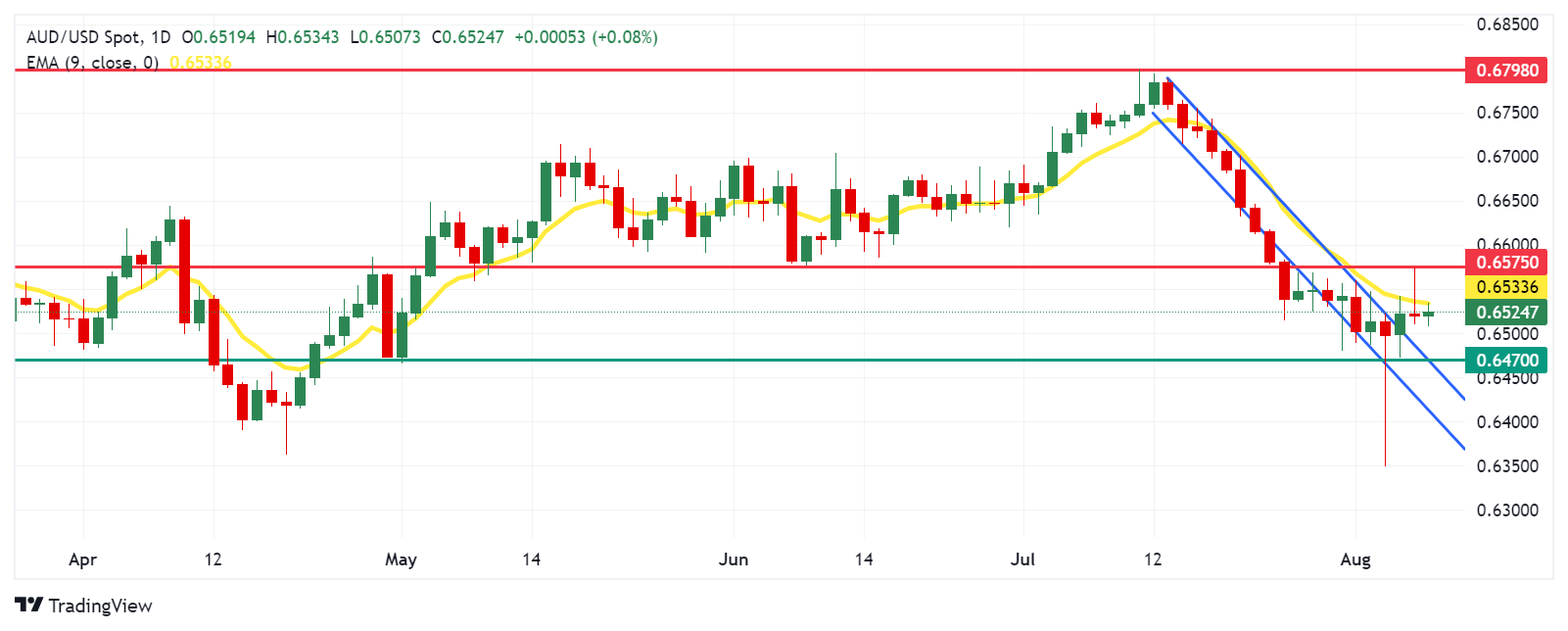- The Australian Dollar edges higher following the hawkish remarks from the RBA Governor Michele Bullock.
- RBA's Bullock stated that inflation may not return to the 2–3% target range until the end of 2025.
- CME FedWatch tool suggests 72.0% odds of a 50-basis point Fed rate cut in September, up from 11.8% last week.
The Australian Dollar (AUD) appreciates against the US Dollar (USD) following the comments from Reserve Bank of Australia (RBA) Governor Michele Bullock on Thursday. Bullock emphasized the need to stay vigilant about inflation risks and indicated a willingness to hike rates if necessary, stating that inflation may not return to the 2–3% target range until the end of 2025.
The US Federal Reserve (Fed) is widely anticipated to implement a more aggressive rate cut beginning in September, following weaker employment data from July that has heightened concerns about a potential US recession.
According to the CME FedWatch tool, there is now a 72.0% probability of a 50-basis point (bps) interest rate cut by the US Federal Reserve (Fed) in September, up from 11.8% a week earlier. The expectation of deeper rate cuts may put pressure on the US Dollar in the near term.
Daily Digest Market Movers: Australian Dollar appreciates following the hawkish RBA
- The Australian Dollar might encounter difficulties due to increased risk aversion linked to escalating tensions in the Middle East. According to two US intelligence officials, Iran and its allies are preparing potential retaliation against Israel. This response is expected following the recent killings of a top military commander of Iran’s Hezbollah in Lebanon and a senior Hamas leader in Tehran, as reported by CNN.
- China's Trade Balance showed a surplus of 84.65 billion for July, falling short of the 99.0 billion expected and 99.05 billion previously. Exports (YoY) came in at 7.0% vs. 9.7% expected and 8.6% previously. Meanwhile, Imports increased 7.2% YoY against 3.5% expected, swinging from a decline of 2.3% prior. Any change in the Chinese economy could impact the Australian market as both countries are close trade partners.
- The AiG Australian Industry Index showed a slight easing in contraction in July, improving to -20.7 from the previous -25.6 reading. Despite this improvement, the index has indicated contraction for the past twenty-seven months.
- On Wednesday, Treasurer Jim Chalmers contested the RBA's view that the economy remains too robust and that large government budgets are contributing to prolonged inflation, according to Macrobusiness.
- On Tuesday, RBA Governor Michele Bullock mentioned that the board had seriously considered increasing the cash rate from 4.35% to 4.6% due to ongoing concerns about excess demand in the economy. Additionally, RBA Chief Economist Sarah Hunter noted on Wednesday that the Australian economy is performing somewhat stronger than previously anticipated by the RBA.
- According to Reuters, Federal Reserve Bank of San Francisco President Mary Daly expressed increased confidence on Monday that US inflation is moving towards the Fed's 2% target. Daly noted that “risks to the Fed's mandates are becoming more balanced and that there is openness to the possibility of cutting rates in upcoming meetings.”
- Chicago Fed President Austan Goolsbee stated on Monday that the US central bank is prepared to act if economic or financial conditions worsen. Goolsbee emphasized, "We're forward-looking about it, and so if the conditions collectively start coming in like that on the through line, there’s deterioration on any of those parts, we’re going to fix it.” according to Reuters.
Technical Analysis: Australian Dollar hovers around 0.6550
The Australian Dollar trades around 0.6530 on Thursday. The daily chart analysis shows that the AUD/USD pair is consolidating above the descending channel, signaling a weakening of a bearish bias. Furthermore, the 14-day Relative Strength Index (RSI) is rising from the oversold 30 level, indicating a potential for further upward movement.
In terms of support, the AUD/USD pair may find support at the upper boundary of the descending channel around the throwback support of 0.6470 level. A break below the latter could exert downward pressure on the pair to test the lower boundary of the descending channel around the level of 0.6420
On the upside, the nine-day Exponential Moving Average (EMA) at 0.6535 serves as immediate resistance, with additional resistance at the 0.6575 level, where "throwback support" has turned into resistance. A breakout above this level could push the AUD/USD pair toward a six-month high of 0.6798.
AUD/USD: Daily Chart
Australian Dollar PRICE Today
The table below shows the percentage change of Australian Dollar (AUD) against listed major currencies today. Australian Dollar was the strongest against the US Dollar.
| USD | EUR | GBP | JPY | CAD | AUD | NZD | CHF | |
|---|---|---|---|---|---|---|---|---|
| USD | -0.13% | -0.06% | -0.54% | -0.14% | -0.44% | -0.07% | -0.40% | |
| EUR | 0.13% | 0.08% | -0.38% | -0.03% | -0.32% | 0.06% | -0.28% | |
| GBP | 0.06% | -0.08% | -0.48% | -0.12% | -0.41% | -0.05% | -0.37% | |
| JPY | 0.54% | 0.38% | 0.48% | 0.35% | 0.07% | 0.40% | 0.10% | |
| CAD | 0.14% | 0.03% | 0.12% | -0.35% | -0.29% | 0.08% | -0.25% | |
| AUD | 0.44% | 0.32% | 0.41% | -0.07% | 0.29% | 0.37% | 0.04% | |
| NZD | 0.07% | -0.06% | 0.05% | -0.40% | -0.08% | -0.37% | -0.33% | |
| CHF | 0.40% | 0.28% | 0.37% | -0.10% | 0.25% | -0.04% | 0.33% |
The heat map shows percentage changes of major currencies against each other. The base currency is picked from the left column, while the quote currency is picked from the top row. For example, if you pick the Australian Dollar from the left column and move along the horizontal line to the US Dollar, the percentage change displayed in the box will represent AUD (base)/USD (quote).
Interest rates FAQs
Interest rates are charged by financial institutions on loans to borrowers and are paid as interest to savers and depositors. They are influenced by base lending rates, which are set by central banks in response to changes in the economy. Central banks normally have a mandate to ensure price stability, which in most cases means targeting a core inflation rate of around 2%. If inflation falls below target the central bank may cut base lending rates, with a view to stimulating lending and boosting the economy. If inflation rises substantially above 2% it normally results in the central bank raising base lending rates in an attempt to lower inflation.
Higher interest rates generally help strengthen a country’s currency as they make it a more attractive place for global investors to park their money.
Higher interest rates overall weigh on the price of Gold because they increase the opportunity cost of holding Gold instead of investing in an interest-bearing asset or placing cash in the bank. If interest rates are high that usually pushes up the price of the US Dollar (USD), and since Gold is priced in Dollars, this has the effect of lowering the price of Gold.
The Fed funds rate is the overnight rate at which US banks lend to each other. It is the oft-quoted headline rate set by the Federal Reserve at its FOMC meetings. It is set as a range, for example 4.75%-5.00%, though the upper limit (in that case 5.00%) is the quoted figure. Market expectations for future Fed funds rate are tracked by the CME FedWatch tool, which shapes how many financial markets behave in anticipation of future Federal Reserve monetary policy decisions.
Information on these pages contains forward-looking statements that involve risks and uncertainties. Markets and instruments profiled on this page are for informational purposes only and should not in any way come across as a recommendation to buy or sell in these assets. You should do your own thorough research before making any investment decisions. FXStreet does not in any way guarantee that this information is free from mistakes, errors, or material misstatements. It also does not guarantee that this information is of a timely nature. Investing in Open Markets involves a great deal of risk, including the loss of all or a portion of your investment, as well as emotional distress. All risks, losses and costs associated with investing, including total loss of principal, are your responsibility. The views and opinions expressed in this article are those of the authors and do not necessarily reflect the official policy or position of FXStreet nor its advertisers. The author will not be held responsible for information that is found at the end of links posted on this page.
If not otherwise explicitly mentioned in the body of the article, at the time of writing, the author has no position in any stock mentioned in this article and no business relationship with any company mentioned. The author has not received compensation for writing this article, other than from FXStreet.
FXStreet and the author do not provide personalized recommendations. The author makes no representations as to the accuracy, completeness, or suitability of this information. FXStreet and the author will not be liable for any errors, omissions or any losses, injuries or damages arising from this information and its display or use. Errors and omissions excepted.
The author and FXStreet are not registered investment advisors and nothing in this article is intended to be investment advice.
Recommended content
Editors’ Picks

EUR/USD holds losses below 1.1400 ahead of ECB policy decision
EUR/USD stays on the back foot below 1.1400 in the European session on Thursday. The pair loses ground on the back of a broad US Dollar rebound and as traders remain cautious ahead of the European Central Bank interest rate decision and Lagarde's press conference.

GBP/USD stays defensive near 1.3250 as US Dollar bounces
GBP/USD stays defensive near 1.3250 in Thursday's European trading, snapping its seven-day winning streak. A tepid US Dollar recovery amid risk appetite prompts the pair to pullback from six-month highs of 1.3292 set on Wednesday. Traders look to tariff headlibnes and US data for fresh impetus.

Gold price retreats from record high as profit-taking kicks in
Gold price retreats after touching a fresh all-time peak earlier this Thursday and erodes a part of the previous day's blowout rally though the downside remains cushioned. A slight improvement in the global risk sentiment, bolstered by hopes of US trade negotiations, turns out to be a key factor undermining the precious metal.

European Central Bank set to cut interest rates again amid easing inflation and tariff uncertainty
The European Central Bank will announce its April interest rate decision on Thursday at 12:15 GMT. Markets widely expect the central bank to lower key rates for the sixth consecutive time. This time the ECB is set to deliver another 25 basis points (bps) cut after the April policy meeting.

Future-proofing portfolios: A playbook for tariff and recession risks
It does seem like we will be talking tariffs for a while. And if tariffs stay — in some shape or form — even after negotiations, we’ll likely be talking about recession too. Higher input costs, persistent inflation, and tighter monetary policy are already weighing on global growth.

The Best brokers to trade EUR/USD
SPONSORED Discover the top brokers for trading EUR/USD in 2025. Our list features brokers with competitive spreads, fast execution, and powerful platforms. Whether you're a beginner or an expert, find the right partner to navigate the dynamic Forex market.




